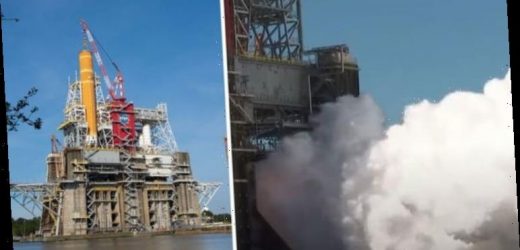Artemis Moon Rocket: NASA conducts second hot fire test
When you subscribe we will use the information you provide to send you these newsletters.Sometimes they’ll include recommendations for other related newsletters or services we offer.Our Privacy Notice explains more about how we use your data, and your rights.You can unsubscribe at any time.
NASA completed a static fire test of its Space Launch System (SLS) rockets as the space agency fired the future traveller to the Moon up. SLS are the rockets used for the Artemis program, which includes a variety of goals including building a lunar orbiter.
The test saw all four of the RS-25 engines ignited in order to see if the rocket generated enough thrust to carry it and astronauts to the Moon.
NASA live-streamed the event on its website, treating fans to the powerful spectacle.
Smoke could be seen billowing away from the rockets as they ploughed through 700,000 gallons of fuel.
NASA said the test, which was the final static fire test, went as smoothly as it could possibly go, with the space agency collecting valuable data for its future Moon missions.
The test began at 8.40PM GMT and lasted for eight minutes.
NASA said: “The hot fire got underway at around 4.40 PM EDT with all four RS-25 engines ignited successfully and produced 1.6 million pounds of thrust, as they will to launch the Artemis I mission to the Moon.
“During the test the engines consumed more than 700,000 gallons of liquid oxygen and liquid hydrogen propellant.
“The test was conducted with the core stage that will launch that first Artemis mission.
“Engineers collect data on how the stage behaved during critical operations, such as throttling the engines up and down and moving the engines dynamically in a variety of patterns.
“In coming days, engineers will scrutinise the data and determine if the stage is ready to be delivered to NASA’s Kennedy Space Center in Florida where it will be integrated with the twin solid rocket boosters already stacked in the Vehicle Assembly Building.”
NASA is gearing up to send humans back to the Moon for the first time since 1972 as part of the Artemis mission.
The first astronauts there, which will include the first woman to ever step foot on our lunar satellite, will be tasked with building a lunar base.
This year, NASA will launch its first Artemis program rocket, Artemis 1, which will be an uncrewed mission to the Moon.
The rocket will carry the Orion spacecraft, which will orbit the Moon, and is set to take off in late 2021.
The spaceship will give experts the chance to understand how Orion performs in space in preparation for crewed missions in the near future.
Source: Read Full Article






